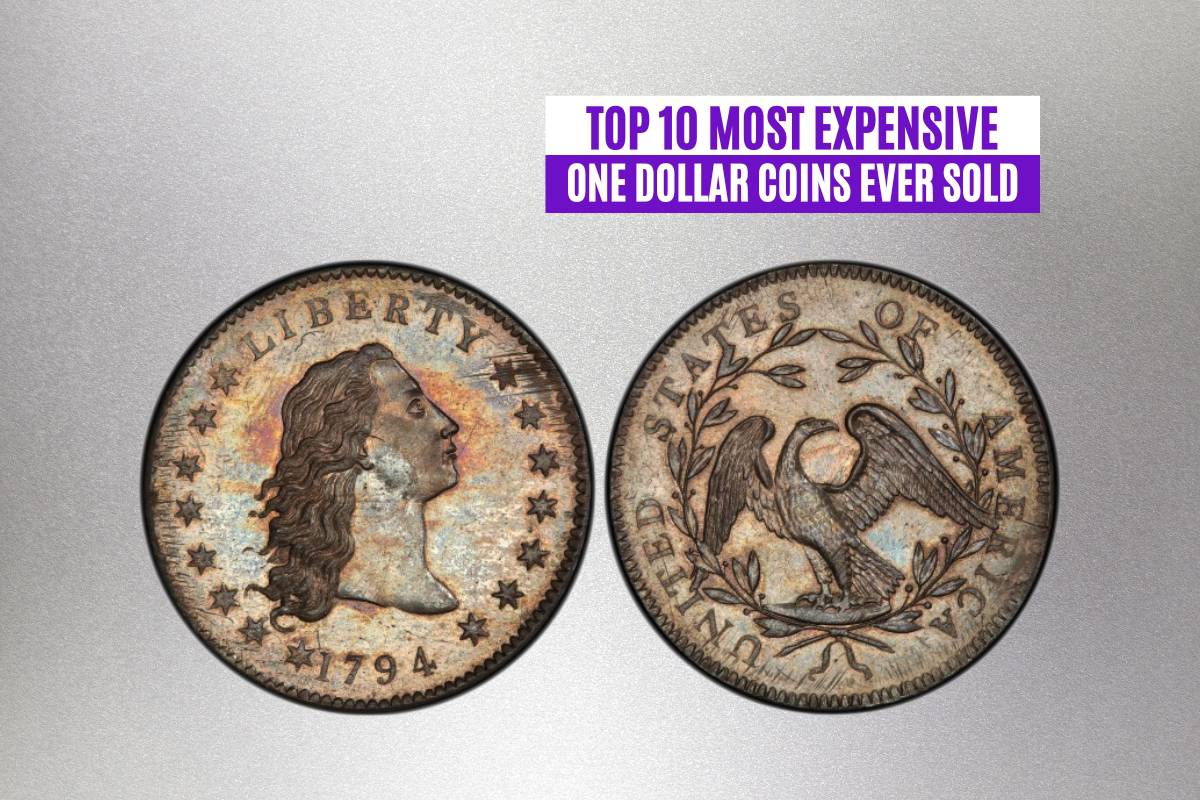The U.S. Mint stopped producing for-circulation one-dollar coins in 2011, though they still make collectible silver dollars for numismatists. Still, these modern one-dollar pieces are far less valuable than those struck more than a century ago. Some of these silver dollar coins are worth millions!
The most expensive one dollar coins are often 1794 Flowing Hair silver dollars. These coins have sold for up to $12 million. The most valuable 1794 Flowering Hair silver dollar is a one-of-a-kind special strike coin with a PCGS grade of SP-66.
This article will explore the most expensive U.S. dollar coins ever sold. If you’re curious to find out just how much one dollar can stretch (in coin form), this ranking is for you.
Here Are the Top 10 Most Expensive Dollar Coins Ever Sold:
- 1794 Flowing Hair Silver Dollar – $12 million
- 1804 Draped Bust Silver Dollar – $7.68 million
- 1794 Flowing Hair Silver Dollar (B-1 BB-1) – $6.6 million
- 1885 Trade Dollar (Proof) – $3.96 million
- 1804 Draped Bust Silver Dollar (Amon Carter Specimen) – $2.3 million
- 1893-S Morgan Silver Dollar – $2.086 million
- 1795 Flowing Hair Dollar (3 Leaves) – $1.265 million
- 1866 Seated Liberty Dollar (No Motto, Proof) – $1.207 million
- 1796 Draped Bust Dollar – $1.175 million
- 1795 Draped Bust Dollar (Off-Center Bust) – $1.057 million
10. 1795 Draped Bust Dollar (Off-Center Bust) – $1.057 Million
Grade: PCGS SP-66
Auction House: Stack’s Bowers
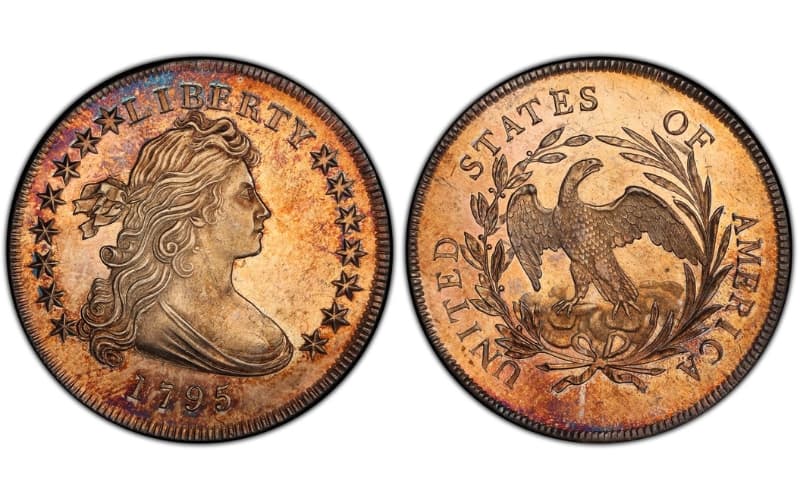
The first U.S. dollar coins were struck in 1794, but the initial design for the coin (Flowing Hair) was changed a year later. This new design, called the Draped Bust, had a much longer lifespan, lasting until 1804.
Still, as you might imagine, it’s challenging to find these two-century-old coins nowadays. This scarcity, coupled with the historical significance and high silver content of the early U.S. dollar coins, makes them high-valued pieces that often sell for a fortune.
The off-center bust 1795 Draped Bust dollar is no exception. This special strike coin sold for $1.057 million when it went to auction in 2016.
One of the most appealing aspects of this coin is its high-relief devices and exceptional reflectivity. Although its coloration isn’t purely silver (featuring traces of copper toning throughout), its condition is astounding, especially considering its age. In all likelihood, this piece was painstakingly created for a particular collector.
It might even be the very first Draped Bust silver dollar ever struck, increasing its historical significance and desirability among numismatists (coin collectors).
9. 1796 Draped Bust Dollar – $1.175 Million
Grade: NGC MS-65 CAC
Auction House: Heritage Auctions
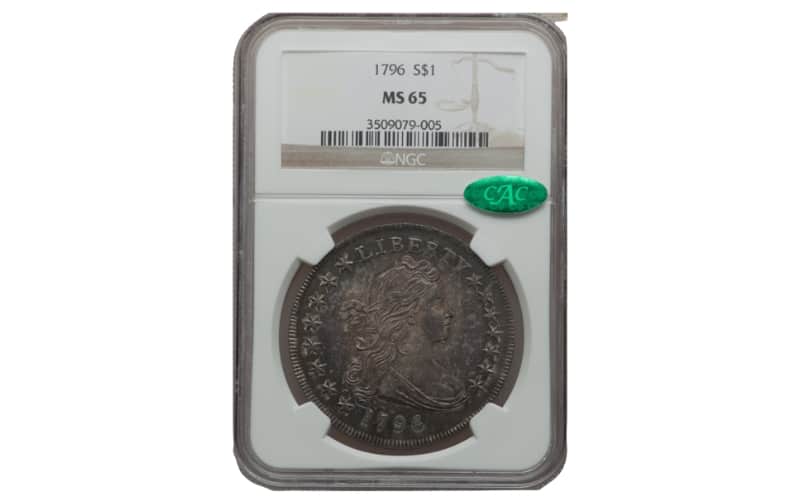
The slightly iridescent 1796 Draped Bust dollar (with a small date and letters) isn’t perfect. Its design is slightly off-center, with numerals that lean significantly. However, this dollar coin is one of the rarest and oldest of the bunch.
Created from the B-2 BB-63 die, this coin is one of fewer than 200 surviving examples. It’s also in exceptional condition, as evidenced by its coveted green CAC (Certified Acceptance Corporation) sticker and NGC grade of MS-65.
Although there are some small signs of wear, this one-dollar piece retains its silvery luster; even more than 200 years after being struck! Because of its rarity and stellar condition, it sold for $1.175 million when it went to auction in 2013.
Notably, by the time this dollar coin was produced, its predecessor (the Flowing Hair silver dollar) had been officially retired.
Several dies had been created with the new Draped Bust design, but these dies weren’t identical, as hi-tech metalworking was still decades (if not centuries) away. As a result, 1796 Draped Bust dollars vary significantly depending on the type of die used to strike them.
8. 1866 Seated Liberty Dollar (No Motto, Proof) – $1.207 Million
Grade: NGC PR-63
Auction House: American Numismatic Rarities
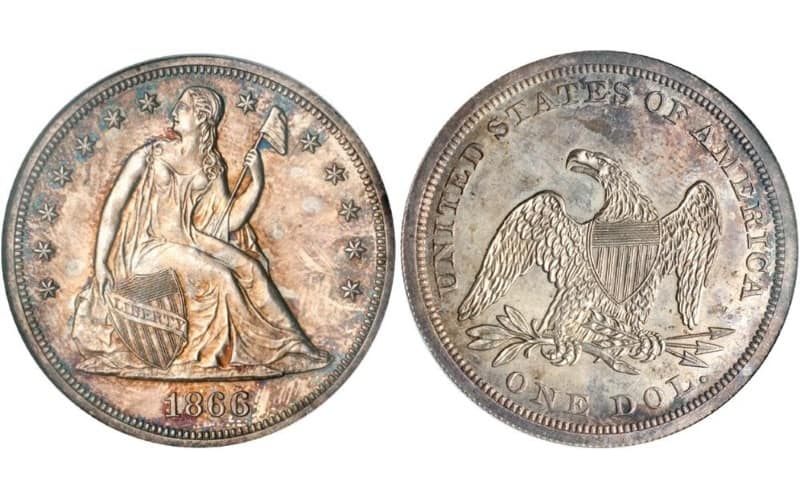
Scarcity can do wonders for the price of any item, including silver dollars. For this reason, you’ll find that several of the most expensive dollar coins are incredibly rare, especially compared to today’s more common commemorative silver dollar coins.
The motto-free 1866 Seated Liberty dollar is a fantastic example of this phenomenon. Only two of these proof coins were struck, making them some of the hardest-to-find one-dollar pieces.
When this “no motto” coin went to auction in 2005, it sold for $1.207 million!
This coin features the Seated Liberty design, first introduced in 1836 before being retired in 1873. But unlike other proof versions of the 1866 Seated Liberty dollar coin, this one lacked the motto banner that sat above the eagle on the reverse (back) face.
It also had a unique coloration thanks to its cameo effect.
Unlike regular strike or standard proof coins, cameo coins have an almost two-tone appearance, typically featuring a darker field (background) and brighter relief (device). This difference in shading makes cameo coins far more eye-catching than other types of coins, which can increase their value.
7. 1795 Flowing Hair Dollar (3 Leaves) – $1.265 Million
Grade: V CH TO GEM UNC
Auction House: Coinhunter
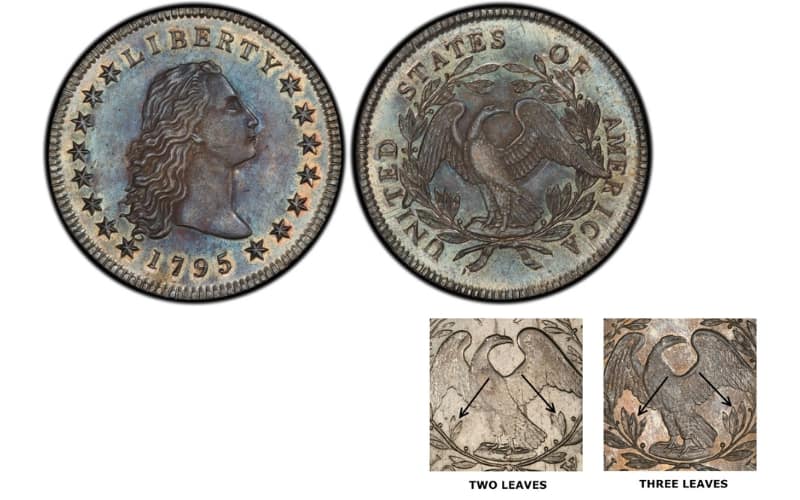
1795 was the second and final year of the Flowing Hair dollar, and it heralded a few notable die changes.
The U.S. Mint, founded only three years earlier (in 1792), was experimenting with minting processes and coin dies during this early period. As a result, many early coins, including dollar pieces, vary significantly in terms of minute design choices.
The 1795 Flowing Hair silver dollar (with three leaves) shows how these early coins’ designs evolved and changed over short periods.
While the bulk of 1795 Flowing Hair dollars featured a reverse (back) design showing an eagle standing on a wreath, with two leaves positioned to the side of each of the bird’s feet, the 3-Leaves 1795 Flowing Hair dollar coin had (you guessed it) three leaves in this spot.
It’s estimated that only about 160,295 of these coins were minted, with approximately 6,000 surviving to the present day. Fewer than five are believed to be PCGS grade MS-65 or better.
As such, when an originally labeled very choice to gem uncirculated 3-Leaves 1795 Flowing Hair dollar coin went to auction in 2005, it quickly sold for $1.265 million. This 3-Leaves 1795 Flowing Hair dollar might be the finest of all remaining examples.
6. 1893-S Morgan Silver Dollar – $2.086 Million
Grade: PCGS MS-67 CAC
Auction House: GreatCollections
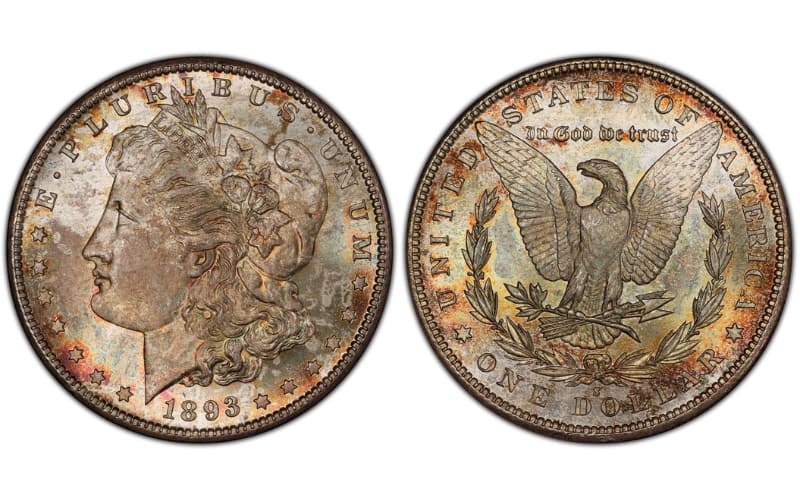
The Morgan silver dollar is one of the most unique one-dollar coins ever produced by the U.S. Mint. Originally struck between 1878 and 1904, they saw a brief resurgence in 1921, then again (in a commemorative form) in 2021.
Unlike previous iterations of U.S. dollar coins, the Morgan silver dollar had a distinctly European aesthetic, with a crowned Lady Liberty on the obverse (front) side and an unusually angular eagle on the reverse (back) face.
The least valuable of these one-dollar coins tend to be those minted in 1921, as they’re more numerous than older pieces. And the holy grail of all Morgan silver dollars is the 1893-S version.
The San Francisco Mint struck only 100,000 of these coins, making them exceedingly rare, even for the time. But the most precious of these dollar pieces is an MS-67 CAC coin that sold for $2.086 million in 2021.
Like a handful of other proof-like dollar coins, this one was likely struck for a specific collector; in this case, Cornelius Vermeule. It was then carefully handed down, generation to generation. It wasn’t until 2001 (more than a century after its creation) that it left the family’s possession and entered the market.
Because it’s such a rare and splendid coin (with a rare CAC sticker), it’s likely to sell for even higher prices in the future.
5. 1804 Draped Bust Silver Dollar (Amon Carter Specimen) – $2.3 Million
Grade: PCGS PR-58
Auction House: Heritage Auctions
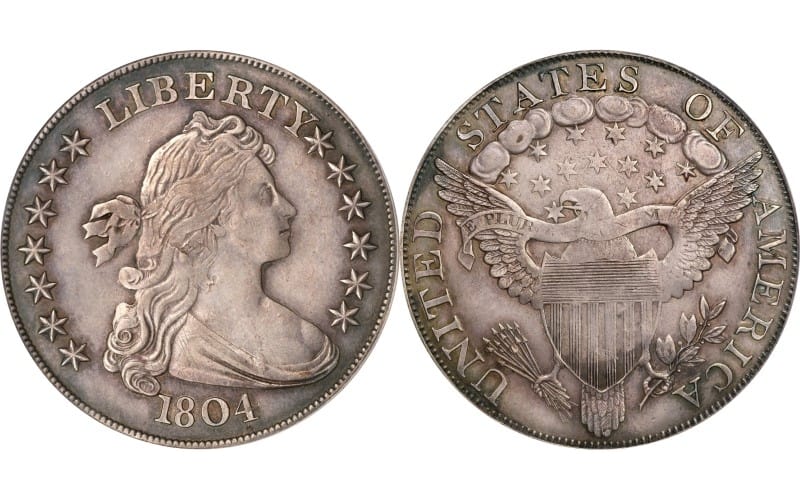
Some coins earn unique nicknames based on their ownership. The 1804 Draped Bust silver dollar (also called the Amon Carter Specimen) is one such coin.
Now, first things first. This silver coin wasn’t actually minted in 1804. In fact, every Draped Bust one-dollar coin that bears the date “1804” was struck in 1834.
The reason for this is a little complicated, but it essentially boils down to a coin die error. In 1804, all Draped Bust silver dollars were struck with coin dies featuring the previous year’s date (1803). So, technically, there aren’t any true 1804 Draped Bust dollar coins.
Between 1806 and 1836, the U.S. Mint didn’t produce any for-circulation silver dollar pieces. But they did produce a limited number of special 1804 Draped Bust silver dollars (again, in 1834, not 1804) for economic trade purposes.
All told, they created 15 of these pieces, many of which are virtually impossible to come by. Still, one of the coins (owned by Amon G. Carter and his family) made its way to auction in 2009, selling for $2.3 million.
However, this 1804 Draped Bust silver dollar isn’t the most valuable example of this highly desirable coin. But we’ll touch on that in just a moment.
4. 1885 Trade Dollar (Proof) – $3.96 Million
Grade: NGC PR-66
Auction House: Heritage Auctions
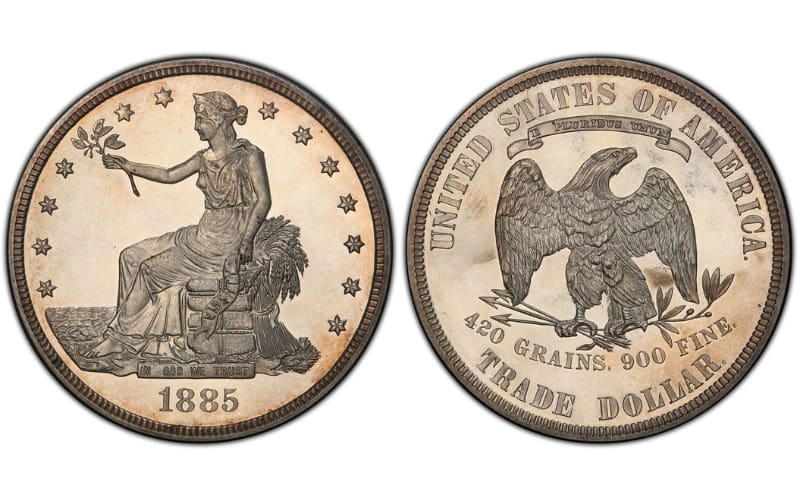
The Trade dollar was introduced in 1873, replacing the Seated Liberty design.
But by 1885, it too was retired in favor of the more popular Morgan silver dollar. This isn’t entirely surprising, as these coins were primarily used as forms of payment overseas (hence the name “trade” dollar), finding little popularity or usefulness in the U.S.
The last few 1885 Trade dollar coins minted in 1885 are particularly valuable, especially proof-strike examples. Rarity plays a significant role in this high valuation, as only five proof 1885 Trade dollar coins were produced.
One of these, perhaps the finest example that survives today, sold for $3.96 million when it went to auction in 2019. It’s in immaculate condition, earning a comparatively high PCGS grade of PR-66.
Without a doubt, this proof-strike 1885 Trade dollar is the most valuable Trade dollar coin ever produced by the U.S. Mint.
3. 1794 Flowing Hair Silver Dollar (B-1 BB-1) – $6.6 Million
Grade: PCGS MS-66+ CAC
Auction House: Heritage Auctions
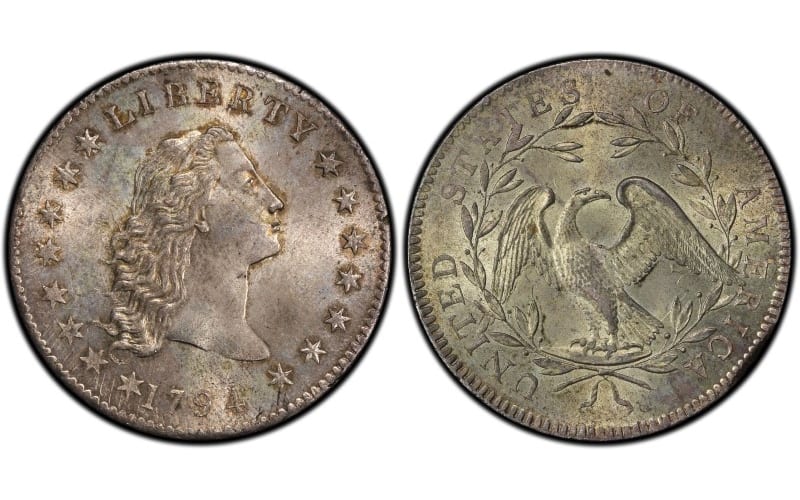
The first one-dollar specimens ever produced by the U.S. Mint were the 1794 Flowing Hair silver dollars, and they remain a must-have (but rare) part of every dedicated numismatist’s coin collection.
But with a mintage of fewer than 2,000, these coins were rare in the late 18th century, only becoming more scarce with the passing decades. Finding one, period, is challenging. But finding one in great shape is even trickier.
One of these silver dollars (the St. Oswald-Ostheimer-Hayes-Pogue coin) sold for $6.6 million in 2021. It’s not difficult to understand why.
This 1794 Flowing Hair silver dollar was struck using a B-1 BB-1 coin die, one of the earliest coin dies created to produce Flowing Hair silver dollar coins. In terms of condition (PCGS MS-66+), no other 1794 Flowing Hair one-dollar coin can rival it.
Still, believe it or not, there is one other 1794 Flowing Hair silver dollar that puts this one-dollar coin’s high auction price to shame. But before we get to that, we need to discuss the most expensive 1804 Draped Bust silver dollar!
2. 1804 Draped Bust Silver Dollar – $7.68 Million
Grade: PCGS PR-68
Auction House: Stack’s Bowers
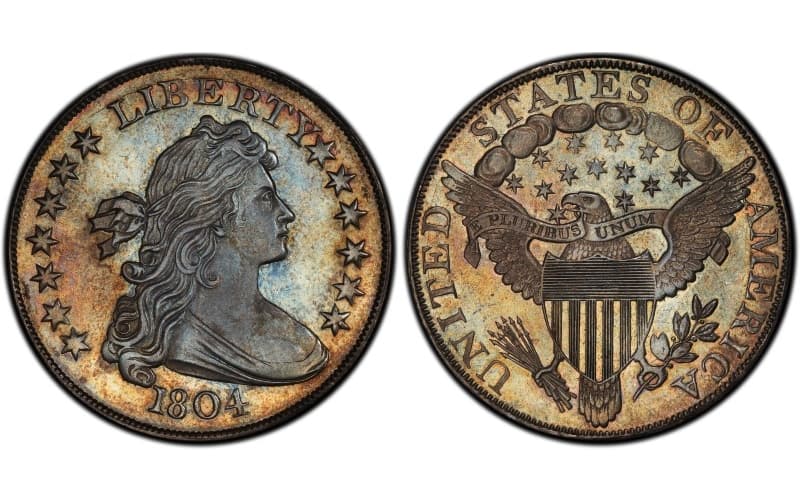
Remember the 1804 Draped Bust silver dollar that was actually minted in 1834?
Well, the PR-58 example mentioned previously isn’t the priciest of these coins. Instead, that honor belongs to a PR-68 (essentially flawless) Class I example that sold for $7.68 million in 2021.
Considering this coin’s rarity (only eight Class I specimens were minted, with 15 1804 pieces struck in total), it’s not particularly surprising that it would reach such a staggering auction price.
Only a single proof-strike 1804 Draped Bust silver dollar has earned a PCGS grade of PR-68, making this coin the finest 1804 Draped Bust dollar in existence. But even though this coin sold for millions, it’s not the priciest one-dollar coin ever sold.
1. 1794 Flowing Hair Silver Dollar – $12 Million
Grade: PCGS SP-66 CAC
Auction House: N/A (Private Sale)
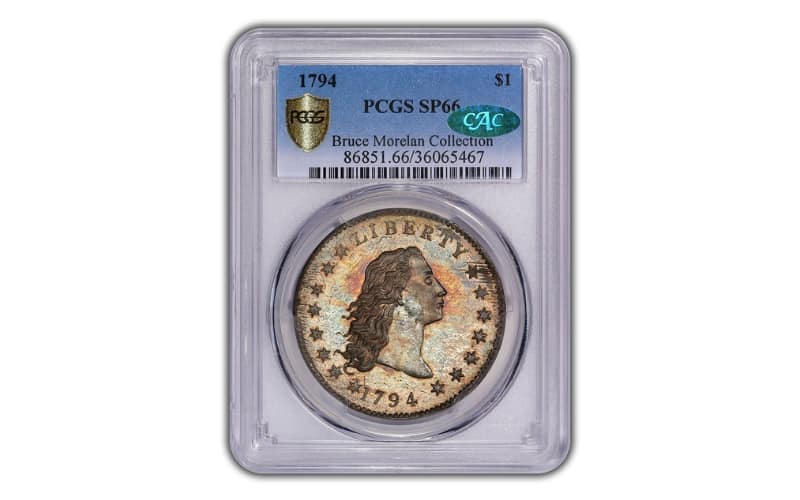
The most expensive one-dollar coin is the special strike 1794 Flowing Hair silver dollar. An SP-66 specimen sold for $10 million in 2013, outselling other 1794 Flowing Hair silver dollar coins by more than $5 million. It’s believed to be the very first silver dollar ever created by the U.S. Mint.
So, even though this 1794 Flowing Hair silver dollar’s PCGS grade is inferior to other examples, it’s considered more valuable due to its historical significance. There only gets to be one “first” U.S. silver dollar, and this one-dollar piece might be that coin.
This coin’s highly coveted and reputable CAC sticker, which denotes its excellence, only makes it more valuable. Still, it’s not the CAC sticker that makes this coin such a valuable piece. Instead, it’s the coin’s historical importance!
In 2022, GreatCollections Auctions acquired this one-of-a-kind coin for $12 million. This coin could end up selling for twice (or even more) this price in the future.
What Are the Most Expensive One Dollar Coins?
The most expensive one dollar coins are 1794 Flowing Hair silver dollars. The priciest is the SP-66 CAC specimen that sold to GreatCollections for $12 million in 2022. This silver coin is likely a one-of-a-kind piece, making it particularly valuable.
The 1804 Draped Bust silver dollar is also a highly valuable specimen, selling for $7.68 million in 2021. Of course, this particular coin was notable for being a proof strike coin with a near-perfect PCGS grade (PR-68).
Would you like to learn more about the world’s most expensive coins? Check out these related articles now!

